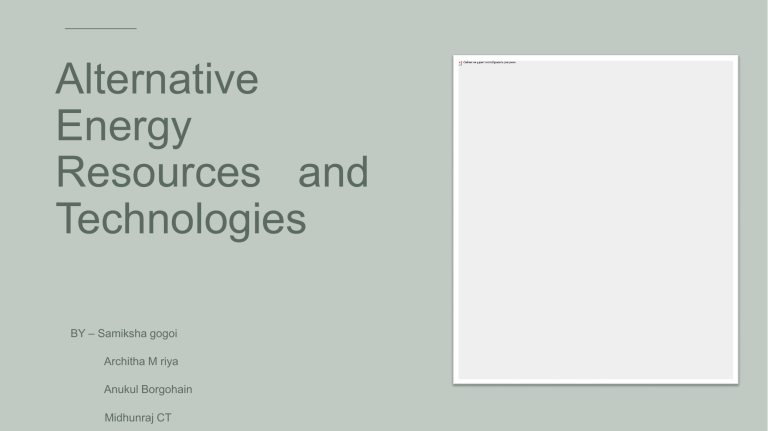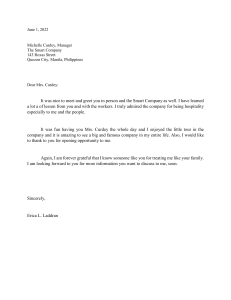
Alternative Energy Resources and Technologies BY – Samiksha gogoi Architha M riya Anukul Borgohain Midhunraj CT Solar powered smart palm trees Smart palm trees have been sprouting up in public places across Dubai. Aside from providing some much needed shade, these man-made trees are self-sustaining, solar-powered charging stations and information points, complete with Wi-Fi and security features. Created as part of Dubai’s smart city initiative, tourists and residents alike can enjoy fast, reliable internet while charging their electronics up to 2.5 times faster than a normal charger. Functional by day, they’re also beautiful by night. The built-in solar panels power green LEDs fitted on top of the palm’s ‘leaves’ creating a sustainable green glow that lights up this increasingly sustainable city. 10/10/2022 2 Footsteps are the future Pavegen have created smart tiles to make every step count. Harnessing kinetic energy from movement, Pavegen technology converts the quick impact from footsteps into continuous power. Effective in high footfall environments, they’ve been installed at places like Heathrow and Abu Dhabi airports, and even Oxford Street in London. ‘Smart streets’ are an interactive infrastructure solution, creating an engaging and interactive experience. Instead of walking through a dull terminal building, users can generate the very energy being used to power the lights and sounds of new high tech, sensory experiences in public spaces all over the world Smart Cities and the Urban Energy Transition • What is a smart city? EDF Energy Research and Development team believe the smart cities concept is the integration and optimization of the complex systems that are used to run cities. By optimizing these systems with smart technology, the ultimate aim is to improve the quality of life of the city's people and make sure resources are distributed efficiently. • Why do we need smart cities? As more and more people move to cities there is increased pressure on city services like its energy supply. The World Energy Council stated: “Reducing the impact of urbanization through increasing energy efficiency and switching to clean, low carbon resources is clearly critical.” This energy transition needs collaboration and innovation across our cities. 10/10/2022 4 • Smart city solutions in practice In order to support the sustainable and smart development of cities, researchers within EDF Group have developed a 3D city platform that helps local authorities evaluate the impacts of various energy strategies. The EDF City Platform is an integrated urban planning tool that also enables city leaders to compare the effects of urban development scenarios pertaining to policies in energy, transport, air quality, water and waste management. • Smart city energy innovation Smart energy solutions will complement the development of smart cities and underpin the operations of other city systems such as transportation, water and health. To meet carbon emission targets, cities are playing an active part in the move towards renewable energy like solar and wind energy. With programmes promoting photovoltaics (solar), wind power, electrical storage and other community energy strategies, cities are encouraging commercial and residential energy generation. 10/10/2022 5 • NET ZERO What is net zero? net zero means cutting greenhouse gas emissions to as close to zero as possible, with any remaining emissions reabsorbed from the atmosphere, by oceans and forests for instance. Why is net zero important? The science shows clearly that in order to avert the worst impacts of climate change and preserve a livable planet, global temperature increase needs to be limited to 1.5°C above pre-industrial levels. Currently, the Earth is already about 1.1°C warmer than it was in the late 1800s, and emissions continue to rise. To keep global warming to no more than 1.5°C – as called for in the Paris Agreement – emissions need to be reduced by 45% by 2030 and reach net zero by 2050. • How can net zero be achieved? Transitioning to a net-zero world is one of the greatest challenges humankind has faced. It calls for nothing less than a complete transformation of how we produce, consume, and move about. The energy sector is the source of around three-quarters of greenhouse gas emissions today and holds the key to averting the worst effects of climate change. Replacing polluting coal, gas and oil-fired power with energy from renewable sources, such as wind or solar, would dramatically reduce carbon emissions. Is there a global effort to reach net zero? Yes, a growing coalition of countries, cities, businesses and other institutions are pledging to get to net-zero emissions. More than 70 countries, including the biggest polluters – China, the United States, and the European Union – have set a net-zero target, covering about 76% of global emissions. Over 1,200 companies have put in place science-based targets in line with net zero, and more than 1000 cities, over 1000 educational institutions, and over 400 financial institutions have joined the Race to Zero, pledging to take rigorous, immediate action to halve global emissions by 2030. 10/10/2022 7 • How do we ensure commitments are turned into action? • The growth in net-zero pledges has been accompanied by a proliferation of criteria with varying levels of robustness. To develop stronger and clearer standards for net-zero emissions pledges by non-State entities such as businesses, investors, cities and regions, and speed up their implementation, UN Secretary-General António Guterres in March 2022 established a High-Level Expert Group on the Net-Zero Emissions Commitments of Non-State Entities. The Expert Group will make recommendations before the end of the year. • Are we on track to reach net zero by 2050? • No, commitments made by governments to date fall far short of what is required. Current national climate plans – for all 193 Parties to the Paris Agreement taken together – would lead to a sizable increase of almost 14% in global greenhouse gas emissions by 2030, compared to 2010 levels. Getting to net zero requires all governments – first and foremost the biggest emitters – to significantly strengthen their Nationally Determined Contributions (NDCs) and take bold, immediate steps towards reducing emissions now. The Glasgow Climate Pact called on all countries to revisit and strengthen the 2030 targets in their NDCs by the end of 2022, to align with the Paris Agreement temperature goal. 10/10/2022 8 Sustainable Innovations In The Energy Industry 1. Lithium-glass Batteries These batteries unlike the traditional have an extremely long lifespan. They have twice the energy density than a normal battery and their capacity grows with age. The batteries charge quicker than any other type, cost less and operate at lower temperatures. 10/10/2022 9 2.3D Printed Solar Energy Trees. 3D printed solar energy trees are wood based stems with solar panel leaves. These were created to replace using wood for energy and instead using sunlight, as most countries still burn wood. These have been designed to look like trees so they can sit within gardens and natural environments. Solar energy trees are also capable of harvesting heat energy. 3.Carbon Nanotube Electricity Carbon nanotubes are carbon atoms rolled up into singular sheet molecules. These can generate electricity and could be used in smaller electrical appliances instead of other energy sources. 4.Solar Roof Tiles Solar panels are usually seen on top of house roofs. This innovation uses the same concept but instead of putting panels on the roof the tiles themselves self are solar panels. Not only does this allow for more solar energy because of the increased surface area, but also eliminates the need for traditional tiles. 10/10/2022 10 5. Waste powered planes Planes are usually powered by fossil fuels which we have a limited supply of, and have a negative impact on the environment. These waste powered planes are powered through fuels made from waste such as wood and home waste which is reacted with catalytic chemicals. But sustainable fuels are also more expensive than traditional jet fuels. Experts said that tax credits and other government incentives might be the only thing to get producers to move toward sustainable fuels. Many members of the airline industry, including major airlines like American Airlines, Delta Air Lines and United Airlines, sent a letter to congressional leaders Friday asking for a tax credit to incentivize the production and use of SAF. In the letter, they asked Congress to provide a tax credit of $1.50 to $2.00 per gallon of SAF. 6.Artificial Photosynthesis Artificial Photosynthesis is the process of capturing and storing the energy from the sunlight. Scientists are also researching how water can be converted into hydrogen and oxygen which could decrease the amount of carbon dioxide in the atmosphere. 10/10/2022 11 7. Solar Powered Trains Solar powered train created and designed by Byron Bay is run completely off renewable energy. The train travels 3 kilometers, and seats 100 passengers. This technology is thought to be useful within cities that have tram systems, especially as in a lot of countries transport is responsible for producing some of the most greenhouse emissions. 10/10/2022 12




